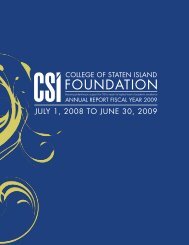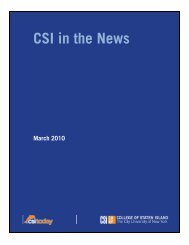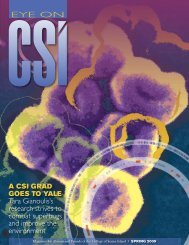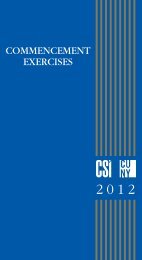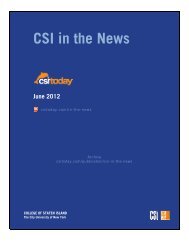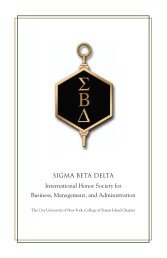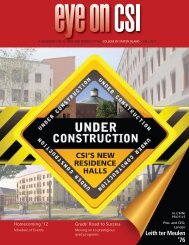Research Poster Presentati<strong>on</strong>sP O S T E R 2 1An Investigati<strong>on</strong> of the Effects ofSocializati<strong>on</strong> of LanguageAcquisiti<strong>on</strong> within InfancyNicholas Dal<strong>on</strong>zo, Kristin Lenzo, Allys<strong>on</strong>PawloskFaculty Mentor: Professor Naomi AldrichDepartment of PsychologyLanguage acquisiti<strong>on</strong> in infancy has l<strong>on</strong>g been ac<strong>on</strong>founding topic in the field of linguistics.Experts have hypothesized that several factors mayc<strong>on</strong>tribute to word acquisiti<strong>on</strong> and associati<strong>on</strong>. Thepresent study explored four main causal factorsthat have been associated with promoting the<strong>on</strong>set of language development in infancy:mother/child interacti<strong>on</strong>, sibling relati<strong>on</strong>ships,media exposure, and schooling enrollment andenvir<strong>on</strong>ment. Specifically, we examined infants’(6- to 14-m<strong>on</strong>ths) behavior with respect tolanguage development and the social interacti<strong>on</strong>sthat promoted these behaviors. Twenty-five parentslocated in New York City were administered adetailed questi<strong>on</strong>naire about their infants, assessingwhether different forms of socializati<strong>on</strong> have asignificant impact <strong>on</strong> language acquisiti<strong>on</strong>.Questi<strong>on</strong>naires were divided into secti<strong>on</strong>s based <strong>on</strong>the aforementi<strong>on</strong>ed subtopics: mother-childinteracti<strong>on</strong>, day care interacti<strong>on</strong>, sibling interacti<strong>on</strong>,and media interacti<strong>on</strong>. We used a correlati<strong>on</strong>aldesign for our survey results. Results established arelati<strong>on</strong>ship between both the age of initiallanguage development and the four categories ofsocializati<strong>on</strong>. Based <strong>on</strong> our findings, we c<strong>on</strong>cludedthat external factors lead to language development.We found there to be a str<strong>on</strong>g relati<strong>on</strong>ship betweenexposure to socializati<strong>on</strong> and the development oflanguage in infancy.P O S T E R 2 3An Investigati<strong>on</strong> of the Impact ofChildren's Programming <strong>on</strong>Developing Gender RolesJennifer Carri<strong>on</strong>, AlyssaFazio,Jacqueline Imbemba, Kayla MeraFaculty Mentor: Professor Naomi AldrichDepartment of PsychologyThe present study examined the impact ofchildren’s televisi<strong>on</strong> programming <strong>on</strong> developinggender roles. Research suggests that as children arebecoming aware of their gender, they begin toshape their behavior and pers<strong>on</strong>ality according torole models of the same sex (Luecke-Aleksa et al.,1995). Research has shown that children’s selecti<strong>on</strong>of televisi<strong>on</strong> programs is gender-based as well: boystend to watch male-oriented televisi<strong>on</strong> shows,whereas girls tend to watch female-orientedtelevisi<strong>on</strong> programming. In doing so, <strong>research</strong>ershave found that children who are exposed togender stereotypes <strong>on</strong> televisi<strong>on</strong> are more likely toendorse gender stereotypes and act in a genderstereotyped manner (Aubrey & Harris<strong>on</strong>, 2004). Inan effort to assess the gender-stereotyped c<strong>on</strong>tentof children’s televisi<strong>on</strong> programming, the currentstudy examined the c<strong>on</strong>tent of two shows that varyaccording to gender orientati<strong>on</strong>: Go, Diego, Go!(male-oriented) and Dora the Explorer (femaleoriented).The episodes were selected based <strong>on</strong>similar thematic focus and equal running times. Toevaluate the stereotypical c<strong>on</strong>tent within theepisodes, 22 <strong>research</strong> assistants coded the colorscheme of the characters’ clothing and accessories,the gender of the characters (giving assistance andreceiving assistance), the use of singing andlaughter to express emoti<strong>on</strong>s, and the color schemeof the envir<strong>on</strong>ment. Analyses revealed differencesbetween the episodes that are c<strong>on</strong>sistent with thegender –stereotypical c<strong>on</strong>tent identified in theliterature. Overall, the results indicate that thec<strong>on</strong>tent of Dora the Explorer and Go, Diego, Go!promote gender stereotypes that could potentiallyaffect children’s gender role development.38
Research Poster Presentati<strong>on</strong>sP O S T E R 2 5The Effects of Signaled Delay andIntertrial Interval Durati<strong>on</strong> <strong>on</strong>Discriminati<strong>on</strong> Learning in Pige<strong>on</strong>sAlexa J. Cimbal, Julyse A.Migan-Gand<strong>on</strong>ou CuFaculty Mentor: Dr. Bertram PloogDepartment of PsychologySixteen pige<strong>on</strong>s learned a series of reversals of asimultaneous red-green visual discriminati<strong>on</strong> with areinforcement delay of 6 s. The signal presentedduring the reinforcement delay and the intertrialinterval (ITI) was varied between 40-sessi<strong>on</strong>c<strong>on</strong>diti<strong>on</strong>s. The main finding was that performancewith the 8-s ITI was higher than with the 40-s ITIand that the introducti<strong>on</strong> of a novel delay signaldisrupted performance, at least temporarily. Thefinding of an ITI effect suggests that performancedepends critically <strong>on</strong> remembering the outcome ofthe immediately preceding trial. The novel signaleffect suggests that performance depends, at leastin part, <strong>on</strong> the delay signal’s acquisiti<strong>on</strong> ofc<strong>on</strong>diti<strong>on</strong>ed reinforcement properties. The study isstill in progress. Future c<strong>on</strong>diti<strong>on</strong>s will bec<strong>on</strong>ducted in order to (a) replicate the ITI effectand (b) to further understand the role of thedelay signal.P O S T E R 2 6Extending The Census of SimplestHyperbolic KnotsTimothy MullenFaculty Mentor: Dr. Abhijit ChampanerkarDepartment of MathematicsThurst<strong>on</strong>'s seminal work established theimportance of hyperbolic geometry in the study of3-manifold topology and knot theory. It is aninteresting problem to study the geometricproperties of hyperbolic knots. The minimumnumber of ideal tetrahedra used to triangulate ahyperbolic knot complement gives a naturalmeasure of its geometric complexity.The census of hyperbolic knots using this measureof complexity gives a different view of the space ofall knots than the view using the diagrammaticcomplexity of knots i.e., the crossing number ofknots. For example, many of the geometricallysimple knots have very high crossing numbers.Hyperbolic knots with geometric complexity up to6 tetrahedra were found by Callahan-Dean-Weeksand extended to 7 tetrahedra by Champanerkar-Kofman-Patters<strong>on</strong>. In this project we extended theexisting census of simplest hyperbolic knots to 8tetrahedra and are working <strong>on</strong> providing adiagrammatic descripti<strong>on</strong> of all the knots.39



